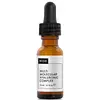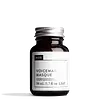What's inside
What's inside
 Key Ingredients
Key Ingredients

 Benefits
Benefits

 Concerns
Concerns

No concerns
 Ingredients Side-by-side
Ingredients Side-by-side

Water
Skin ConditioningGlycerin
HumectantHydrolyzed Yeast Extract
Skin ConditioningSodium Hyaluronate Crosspolymer
HumectantDimethyl Isosorbide
SolventPentylene Glycol
Skin ConditioningSodium Hyaluronate
HumectantHydrolyzed Sodium Hyaluronate
Skin ConditioningSodium Butyroyl Hyaluronate
HumectantPolyacrylate Crosspolymer-6
Emulsion StabilisingDisodium Acetyl Glucosamine Phosphate
Skin ConditioningBetaine
HumectantTrisodium Ethylenediamine Disuccinate
Yeast Extract
Skin ConditioningCetyl Hydroxyethylcellulose
Emulsion StabilisingTamarindus Indica Seed Gum
Emulsion StabilisingTremella Fuciformis Sporocarp Extract
AntioxidantLecithin
EmollientTetradecyl Aminobutyroylvalylaminobutyric Urea Trifluoroacetate
Skin ConditioningMyristoyl Nonapeptide-3
Skin ConditioningMagnesium Chloride
Sodium Benzoate
MaskingPotassium Sorbate
PreservativePPG-26-Buteth-26
Skin ConditioningPEG-40 Hydrogenated Castor Oil
EmulsifyingEthylhexylglycerin
Skin ConditioningChlorphenesin
AntimicrobialPhenoxyethanol
PreservativePolyglucuronic Acid
Skin ConditioningWater, Glycerin, Hydrolyzed Yeast Extract, Sodium Hyaluronate Crosspolymer, Dimethyl Isosorbide, Pentylene Glycol, Sodium Hyaluronate, Hydrolyzed Sodium Hyaluronate, Sodium Butyroyl Hyaluronate, Polyacrylate Crosspolymer-6, Disodium Acetyl Glucosamine Phosphate, Betaine, Trisodium Ethylenediamine Disuccinate, Yeast Extract, Cetyl Hydroxyethylcellulose, Tamarindus Indica Seed Gum, Tremella Fuciformis Sporocarp Extract, Lecithin, Tetradecyl Aminobutyroylvalylaminobutyric Urea Trifluoroacetate, Myristoyl Nonapeptide-3, Magnesium Chloride, Sodium Benzoate, Potassium Sorbate, PPG-26-Buteth-26, PEG-40 Hydrogenated Castor Oil, Ethylhexylglycerin, Chlorphenesin, Phenoxyethanol, Polyglucuronic Acid
Lactococcus Ferment Lysate
Skin ConditioningDimethicone
EmollientCentaurea Cyanus Flower Water
Skin ConditioningGlycerin
HumectantDimethicone/Vinyl Dimethicone Crosspolymer
Skin ConditioningHydroxyethyl Acrylate/Sodium Acryloyldimethyl Taurate Copolymer
Emulsion StabilisingPropanediol
SolventWater
Skin ConditioningPentylene Glycol
Skin ConditioningOriganum Vulgare Leaf Extract
Skin ConditioningLeontopodium Alpinum Callus Culture Extract
AntioxidantPlantago Lanceolata Leaf Extract
AntimicrobialMelanin
Skin ProtectingSodium Hyaluronate
HumectantArginine
MaskingSodium Chloride
MaskingIsohexadecane
EmollientPolysorbate 60
EmulsifyingXanthan Gum
EmulsifyingCitric Acid
BufferingEthoxydiglycol
HumectantPPG-26-Buteth-26
Skin ConditioningPEG-40 Hydrogenated Castor Oil
EmulsifyingPotassium Sorbate
PreservativeSodium Benzoate
MaskingEthylhexylglycerin
Skin ConditioningPhenoxyethanol
PreservativeChlorphenesin
AntimicrobialLactococcus Ferment Lysate, Dimethicone, Centaurea Cyanus Flower Water, Glycerin, Dimethicone/Vinyl Dimethicone Crosspolymer, Hydroxyethyl Acrylate/Sodium Acryloyldimethyl Taurate Copolymer, Propanediol, Water, Pentylene Glycol, Origanum Vulgare Leaf Extract, Leontopodium Alpinum Callus Culture Extract, Plantago Lanceolata Leaf Extract, Melanin, Sodium Hyaluronate, Arginine, Sodium Chloride, Isohexadecane, Polysorbate 60, Xanthan Gum, Citric Acid, Ethoxydiglycol, PPG-26-Buteth-26, PEG-40 Hydrogenated Castor Oil, Potassium Sorbate, Sodium Benzoate, Ethylhexylglycerin, Phenoxyethanol, Chlorphenesin
Ingredients Explained
These ingredients are found in both products.
Ingredients higher up in an ingredient list are typically present in a larger amount.
Chlorphenesin is a synthetic preservative. It helps protect a product against bacteria in order to extend shelf life. In most cases, Chlorphenesin is paired with other preservatives such as phenoxyethanol and caprylyl glycol.
Chlorphenesin is a biocide. This means it is able to help fight the microorganisms on our skin. It is also able to fight odor-releasing bacteria.
Chlorphenesin is soluble in both water and glycerin.
Studies show Chlorphenesin is easily absorbed by our skin. You should speak with a skincare professional if you have concerns about using Chlorphenesin.
Learn more about ChlorphenesinEthylhexylglycerin (we can't pronounce this either) is commonly used as a preservative and skin softener. It is derived from glyceryl.
You might see Ethylhexylglycerin often paired with other preservatives such as phenoxyethanol. Ethylhexylglycerin has been found to increase the effectiveness of these other preservatives.
Glycerin is already naturally found in your skin. It helps moisturize and protect your skin.
A study from 2016 found glycerin to be more effective as a humectant than AHAs and hyaluronic acid.
As a humectant, it helps the skin stay hydrated by pulling moisture to your skin. The low molecular weight of glycerin allows it to pull moisture into the deeper layers of your skin.
Hydrated skin improves your skin barrier; Your skin barrier helps protect against irritants and bacteria.
Glycerin has also been found to have antimicrobial and antiviral properties. Due to these properties, glycerin is often used in wound and burn treatments.
In cosmetics, glycerin is usually derived from plants such as soybean or palm. However, it can also be sourced from animals, such as tallow or animal fat.
This ingredient is organic, colorless, odorless, and non-toxic.
Glycerin is the name for this ingredient in American English. British English uses Glycerol/Glycerine.
Learn more about GlycerinPeg-40 Hydrogenated Castor Oil is derived from castor oil and polyethylene glycol (PEG). It is used as a emollient and emulsifier.
As an emulsifier, it helps prevent ingredients from separating. It also helps make the other ingredients more soluble; it is often used to solubilize fragrances. This increases spreadability and elongates shelf life in a product.
Emollients help soothe and soften the skin. They do this by creating a protective film on your skin. This barrier helps trap moisture and keeps your skin hydrated. Emollients may be effective at treating dry or itchy skin.
This ingredient may or may not be vegan, depending on the source.
Peg-40 Hydrogenated Castor Oil may not be fungal-acne safe. We recommend speaking with a professional if you have any questions or concerns.
Learn more about PEG-40 Hydrogenated Castor OilPentylene glycol is typically used within a product to thicken it. It also adds a smooth, soft, and moisturizing feel to the product. It is naturally found in plants such as sugar beets.
The hydrophilic trait of Pentylene Glycol makes it a humectant. As a humectant, Pentylene Glycol helps draw moisture from the air to your skin. This can help keep your skin hydrated.
This property also makes Pentylene Glycol a great texture enhancer. It can also help thicken or stabilize a product.
Pentylene Glycol also acts as a mild preservative and helps to keep a product microbe-free.
Some people may experience mild eye and skin irritation from Pentylene Glycol. We always recommend speaking with a professional about using this ingredient in your routine.
Pentylene Glycol has a low molecular weight and is part of the 1,2-glycol family.
Learn more about Pentylene GlycolPhenoxyethanol is a preservative that has germicide, antimicrobial, and aromatic properties. Studies show that phenoxyethanol can prevent microbial growth. By itself, it has a scent that is similar to that of a rose.
It's often used in formulations along with Caprylyl Glycol to preserve the shelf life of products.
Potassium Sorbate is a preservative used to prevent yeast and mold in products. It is commonly found in both cosmetic and food products.
This ingredient comes from potassium salt derived from sorbic acid. Sorbic acid is a natural antibiotic and effective against fungus.
Both potassium sorbate and sorbic acid can be found in baked goods, cheeses, dried meats, dried fruit, ice cream, pickles, wine, yogurt, and more.
You'll often find this ingredient used with other preservatives.
Learn more about Potassium SorbateWe don't have a description for PPG-26-Buteth-26 yet.
Sodium Benzoate is a preservative. It's used in both cosmetic and food products to inhibit the growth of mold and bacteria. It is typically produced synthetically.
Both the US FDA and EU Health Committee have approved the use of sodium benzoate. In the US, levels of 0.1% (of the total product) are allowed.
Sodium benzoate works as a preservative by inhibiting the growth of bacteria inside of cells. It prevents the cell from fermenting a type of sugar using an enzyme called phosphofructokinase.
It is the salt of benzoic acid. Foods containing sodium benzoate include soda, salad dressings, condiments, fruit juices, wines, and snack foods.
Studies for using ascorbic acid and sodium benzoate in cosmetics are lacking, especially in skincare routines with multiple steps.
We always recommend speaking with a professional, such as a dermatologist, if you have any concerns.
Learn more about Sodium BenzoateSodium Hyaluronate is hyaluronic acid's salt form. It is commonly derived from the sodium salt of hyaluronic acid.
Like hyaluronic acid, it is great at holding water and acts as a humectant. This makes it a great skin hydrating ingredient.
Sodium Hyaluronate is naturally occurring in our bodies and is mostly found in eye fluid and joints.
These are some other common types of Hyaluronic Acid:
Learn more about Sodium HyaluronateWater. It's the most common cosmetic ingredient of all. You'll usually see it at the top of ingredient lists, meaning that it makes up the largest part of the product.
So why is it so popular? Water most often acts as a solvent - this means that it helps dissolve other ingredients into the formulation.
You'll also recognize water as that liquid we all need to stay alive. If you see this, drink a glass of water. Stay hydrated!
Learn more about Water